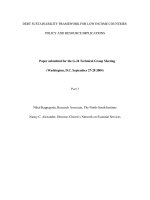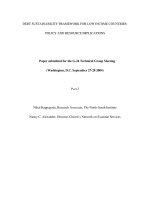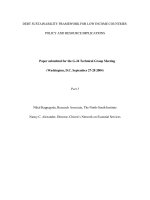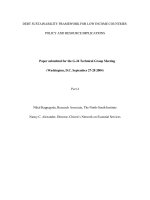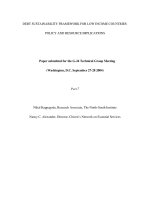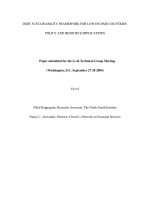Tài liệu DEBT SUSTAINABILITY FRAMEWORK FOR LOW INCOME COUNTRIES : POLICY AND RESOURCE IMPLICATIONS - Part 7 ppt
Bạn đang xem bản rút gọn của tài liệu. Xem và tải ngay bản đầy đủ của tài liệu tại đây (38.36 KB, 8 trang )
DEBT SUSTAINABILITY FRAMEWORK FOR LOW INCOME COUNTRIES:
POLICY AND RESOURCE IMPLICATIONS
Paper submitted for the G-24 Technical Group Meeting
(Washington, D.C. September 27-28 2004)
Part 7
Nihal Kappagoda, Research Associate, The North-South Institute
Nancy C. Alexander, Director, Citizen’s Network on Essential Services
Concerns and Issues
Debt Sustainability Framework
1. There are several concerns relating to the DSFs that need to be kept in
mind and taken account of in determining a country’s strategy for
mobilizing external resources. Many of them are recognized and
described in the Framework Paper and mentioned again in this paper to
complete the description of the DSF.
2. There could be situations when the selected debt indicators are above
the threshold values. It is likely that in such situations there would be
World Bank and/or IMF supported stabilization programs. They would
normally call for reduced levels of borrowing on unaffordable terms,
and for more concessional borrowing and grant financing. The
reduction of the debt ratios to threshold levels is likely to be gradual as
new borrowing on non-concessional terms may have to be made if
concessional funds including grants are not available in the required
amounts.
3. A different set of considerations may prevail if only a single debt
indicator is above the threshold value in which case it is necessary to
examine whether this is due to a debt or other problem. A debt service
problem identified by comparing with GDP, exports or government
revenue may all be affected by statistical issues. Repayment capacity
judged by exports may need to take account of high or fluctuating levels
of workers’ remittances. Similarly government revenue may be affected
by poor tax administration requiring action on widening the tax base and
more effective revenue collection. Thus borrowing decisions based on a
single indicator should take account of the non-debt factors that could
affect the level of the indicator before action is taken on new
borrowings.
4. It is also necessary to identify stock and flow problems in formulating
an appropriate borrowing strategy. A high current debt service ratio
combined with a low level of debt stock needs to be handled as a
liquidity problem and corrective action taken in the short-term. On the
other hand, a low current level of debt service combined with a high
level of debt stock could lead to debt service problems in the future
providing an opportunity for corrective action to be taken in a timely
manner. If a country has both a stock and flow problem a combination
of measures to ease the liquidity constraints and alleviate the longer-
term debt stock problem need to be implemented calling for higher
volumes of concessional lending and grants.
5. Given the importance of DSAs for each low income country in the
application of the DSF and borrowing from the IMF, it is necessary that
these be conducted in a collaborative and transparent manner by the two
institutions. They should work closely with the country authorities and
major creditors to ensure that prospective lending levels and their terms
are taken account of in the DSAs. While the DSAs and risk assessments
are to be done in a collaborative manner, it is understood that each
institution will make its own assessment and report separately to its
respective board.
1
It is recognized that there may be differences
between the Bank and Fund in these assessments and possible scenarios.
It is not known how these will be played out in the countries where they
occur.
6. Vulnerability should also be assessed by estimating non-debt indicators.
Countries that have not liberalized their capital accounts - which is
probably the case for most low income countries - should estimate the
ratios of their international reserves to imports of goods and services
and monitor the reserve level when this ratio declines below the
recommended minimum of 3-4 months. Low income countries that
have liberalized their capital accounts should monitor the level of short-
term debt to international reserves. Indicators of fiscal vulnerability
should also be estimated for all low income countries.
The PBA System
2
1
Debt Sustainability in Low Income Countries: Further Consideration on an Operational Framework and
Policy Implications, IDA/SecM 2004-0629, IDA, September 10 2004.
2
Ibid footnote 16.
7. There are many concerns expressed about the Bank’s allocation system
for IDA resources. A summary of the issues in the ongoing debate are
the following:
• Many are critical of a system, such as the CPIA, that approximates a
“one-size-fits-all” set of “good” policies and “good” institutions. For
instance, there is little agreement about what constitutes “good” trade
policy. Even where there is agreement on general policy principles,
there are still disagreements about the pace, sequence and
implementation of these policies and their impact such as short-term
distributional effects;
• The Bank’s methodology for evaluating a country’s governance -
e.g., its accountability to its citizens - is unreliable. Yet, the CPIA
assigns a greater weight to the governance factor than to any other set of
indicators. Those responsible for formulating the governance indicator
concede that it has a high margin of error;
• When scores relating to certain criteria (e.g., governance, gender,
government accountability) constrain or shape fundamental decisions
relating to resource allocation and the role of the government, the
process may be in conflict with the Articles of Agreement of the World
Bank Group that prohibit interference in a country’s domestic political
affairs;
• The rating system may further exacerbate unequal treatment of
countries by inducing governments with less power and resources to
